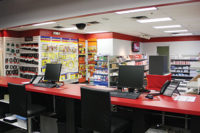Thom Brazel, general manager of West Coast Operations and LEED® AP with Hill York, Sarasota, Fla., works mainly on the service, maintenance, and retrofit side of the commercial-industrial contractor. Even going back just 10-20 years, “What hasn’t changed,” he countered.
What he pointed to is the overall sophistication of the average commercial service contractor. “In the early ’90s when I began in this field, things were more basic. We had just started selling basic PM agreements, including not much more than changing filters, and cleaning coils and drains,” Brazel said. “Since then we have seen service contractors focusing on IAQ, predictive maintenance, performance contracting, LEED, facility management, and energy services and solutions.”
Over the past few years, he said he has seen service contractors treated “more and more as a commodity due to fiscal constraints. The days of being handed business due to a relationship only are fading quickly. Change is now the norm.”
Some may feel that change is scary, but it may be necessary for survival. “One of my largest concerns is that some businesses have not changed over the years by self evaluation and being progressive, but have only changed by forces of the market and equipment improvements,” said Larry Taylor, president of AirRite A/C. “My feeling is that they will be the ones who do not survive future changes in professional contracting.”
Naturally, the professional contractors of today look nothing like the companies of yesteryear. “The owners of successful companies today are much more educated and tuned into the technologies of not only the manufacturers’ products, but of the back-office processes and customer relationship skills needed to become more successful,” Taylor said.
“What I have seen in these companies are well-thought-out business plans, marketing programs, and training on not just technical skills but soft customer skills as well.” Today’s contractors must be “well rounded, balanced, more financially stable, and offer a broader range of services and support systems not only to our external customers, but also to our internal customers.”
Best Practices
One of the more significant recent contractor markets has come from quality initiatives and energy audits, both of which look at the building as a system.
“All of these at times have served as a differentiator for those contractors who embrace them,” said Brazel. “These days, with the lack of new construction and the trying economy, it seems there are small service companies popping up (and going out of business) every day.”
His current company, Hill York, “has been around for 75 years and we continuously look for ways to differentiate ourselves. Right now our strength is in the energy services we offer our customers.”
Taylor said the effects of leading practices like the QI/QC programs, energy audits, whole-house performance evaluations, etc., “are game changers for the new professional contractors of tomorrow. Finally, after 46 years of looking for something to offer our customers in the off seasons and level out our workloads, we may have found it.… we are finding the ability to answer the questions customers have been asking for generations.”
An additional benefit, he said, is that contractors can provide more opportunities, and faster, for the advancement of their employees, “rather than them having to wait for someone to quit or move on.
“The excitement is back in the HVAC-indoor environmental quality (IEQ) business,” he exclaimed. In fact, “we may need to add some letters to HVAC; I don’t think the ‘V’ covers it any longer.”
Customer Changes
How have customers changed in general, and how can contractors use these changes to their advantage? “Their sophistication has improved due to access to digital media, affordable technologies, participation in building management and operation associations, and most recently, the need to survive financially,” Brazel said of his company’s clients.
One way in which some customers have not changed, is that “They continuously demand more and more for the lowest possible price. The successful contractor will have to figure out how to deliver more for less,” Brazel said.
Taylor described dramatic customer changes. “About the only carryover of today’s customers, compared to our 1955 customers, is that they are still customers.” He described their characteristics over the decades:
1960s — “Customers were excited to have the temperature in the home somewhat lower, somewhat cleaner, somewhat dryer, and they were happy, satisfied, and grateful.”
1970s — “The level of expectation became a little higher as more homes became comfort controlled and utility rates were very low,” said Taylor; “highly inefficient installations were not a problem, and we didn’t know much about sizing and humidity problems, so bigger was better.”
1980s — IAQ and health concerns created another level of expectations; “we wanted cleaner air, more even temperatures, and quieter systems.”
1990s — “We began to see the expectations of tighter homes, more efficient systems, better air control, and filtration systems.”
2000 — “With technology changes … customers’ communication ability and expectations began to skyrocket,” Taylor said. “Baby Boomers want better, bigger, faster, etc., and are willing to pay for it.”
2010 — At this point, Taylor said the “now factor” entered the picture. “Customers wanted better comfort systems, more energy efficiency, less noise, tighter homes, and service right now. These expectations are driven by the speed increase and access of the Internet.”
However, marketing information on the Internet can make it seem like systems are pretty much equal, Taylor said. “The X factor is the service, and that seems to be difficult for today’s customers to come to grips with. Once we crack that code, I think we will create another new set of normal expectations.”
On the Horizon?
The commercial service contracting market has recently experienced an influx of “ankle-biters,” as Brazel called former residential/light commercial new construction contractors “who used to focus on new construction, [but] when the housing market tanked, many of these folks decided to participate in the commercial-industrial-institutional markets.
“At first their low pricing attracted many customers away from traditional commercial contractors,” he said. “However, many of these little companies are failing; they are unable to deliver the quality the customers were accustomed to. There is beginning to be a shift back to the more qualified contractors for quality reasons.”
An unfortunate side effect, he said, is that these customers still demand quality, as well as the lowest overall cost. “Those contractors who embrace this trend and look for ways to positively impact every aspect of their customers’ businesses will survive and flourish,” Brazel said. “Those who won’t will go away.
“I expect it will never get back to the way it was five years ago. This tough economy has forced everyone to do more with less, and that trend won’t be going away any time soon.”
According to Taylor, “I feel that the effects of programs for energy efficiency, and the house-as-a-system movement, are going to be the game changers going forward. I also believe we will have completely different models of business in the next few years.”
Regarding equipment, he predicted it would become still more of a commodity. “Many professional contractors will reshape their business model to where the equipment is a draw-through sale,” he predicted. “The real sale to the customer will be the effects of improving their whole-house environment and the many other building science processes; equipment changes and modifications that will happen during that conversion.”
Business uncertainties may slow the transition of some contracting companies into new models, Taylor added. However, “One thing I have always enjoyed about this business is that we are always changing, and as the saying goes, in life change is inevitable — in business it is vital.”
Publication date: 09/19/2011





Report Abusive Comment